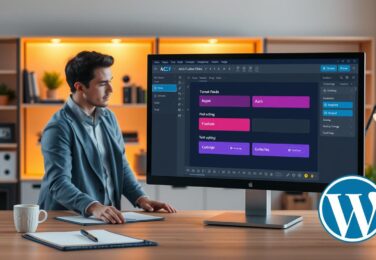How much does it cost to build a website in Sydney?

Table of Content
As a small business owner in Sydney, I’ve always been drawn to the world of website development. It seemed like a great way to grow my online presence and reach more people. But, I often wondered, “How much does it really cost to build a website in Sydney?”
Over time, I’ve heard many stories about website costs. Some said it was worth it, while others warned of unexpected expenses. I wanted to make a smart choice that fit my business and budget.
This guide will cover what affects website costs in Sydney. It aims to help you make a wise choice for your online success. It’s for small business owners, startup founders, or anyone wanting a strong online presence in our city.
Key Takeaways
- Discover the key factors that influence website development costs in Sydney
- Understand the importance of responsive design and mobile-friendly websites
- Explore the advantages of web applications and their impact on user experience
- Delve into the roles of front-end and back-end development in creating a robust website
- Learn about content management systems and their ability to streamline your workflow
- Discover e-commerce solutions that can boost your online sales
- Uncover the significance of web hosting and website maintenance in sustaining your online presence
Introduction to Website Development Costs
Building a website in Sydney can be costly. The price varies a lot, depending on several factors. We’ll look at what makes website development cost what it does, so you know what to expect for your online presence.
Factors Influencing Website Pricing
Several important things affect the cost of making a website in Sydney. These include:
- Website Complexity – A complex website costs more. Things like online shops, videos, and special coding can raise the price.
- Design and Branding – A unique look and strong brand costs more than a simple design.
- Content Management System (CMS) – The CMS you pick, like WordPress or Joomla, changes the cost and upkeep of your site.
- Ongoing Maintenance and Updates – Keeping your site updated and secure costs money over time.
- Developer Expertise – The skill and experience of the developers can greatly affect the total cost.
| Factor | Impact on Website Pricing |
|---|---|
| Website Complexity | Higher complexity = Higher cost |
| Design and Branding | Unique design = Higher cost |
| Content Management System (CMS) | Customized CMS = Higher cost |
| Ongoing Maintenance and Updates | Regular updates = Recurring cost |
| Developer Expertise | Experienced developers = Higher cost |
Knowing these factors helps you guess the cost of making a website in Sydney. This way, you can make smart choices about your online investment.
Website Development: A Comprehensive Guide
Creating a website is a detailed process that includes planning, design, and implementation. We’ll guide you through the main steps of making a website. This will help you know how to make your project a success.
The first step is thorough planning. You need to define your website’s goals, who you want to reach, and what features you need. Good planning is key to a website that’s easy to use and works well.
Then, the design phase starts. Our designers work on making a design that looks good and is easy to use. They focus on making a layout that’s pleasing, choosing the right fonts, and adding elements that match your brand for a great user experience.
- Responsive design for all devices
- Eye-catching images and multimedia
- Following web design standards
The web development process turns the design into a working website. Our developers use the latest website development tools and frameworks to make your idea real.
| Key Stages | Description |
|---|---|
| Front-end Development | Works on the parts of the website that users see, making sure it’s easy and fun to use. |
| Back-end Development | Handles the server side, managing data, APIs, and overall site functionality. |
| Web Development Process | Combines front-end and back-end work to make a website that works well and performs well. |
Before launching, the website is tested and optimized. This makes sure your site looks good, is easy to use, and works well. It’s ready to attract and engage your audience.
“Developing a website is not just about creating a digital presence; it’s about crafting an experience that resonates with your audience and drives your business forward.”
Knowing the full website development process helps you make better choices. It lets you work well with our team and reach your online goals.
Responsive Design: The Key to Success
In today’s digital world, having a website that works well on all devices is crucial. Responsive design is key for a good online presence. It makes sure your site works well on desktops, tablets, or phones, giving everyone a great experience.
Mobile-Friendly Websites: A Must-Have
Most internet users now use mobile devices, making a mobile-friendly website a must for businesses and organizations. With responsive design, your site changes to fit any device. This means no need for a special mobile site.
Choosing responsive design means your site looks and works great on any device. This improves user experience and helps your site show up higher in search results. Search engines like Google give mobile-friendly sites a boost.
| Key Benefits of Responsive Design | Impact on User Experience |
|---|---|
|
|
Choosing responsive design means your website stays useful and engaging for everyone, no matter how they visit it. This focus on being mobile-friendly is essential for success online today.
Web Applications: Enhancing User Experience
In the fast-paced world of web development, web applications are key to making online experiences better. These programs add interactivity to websites, making them more engaging and satisfying for users.
Web applications make websites more dynamic and easy to use. They offer features like interactive forms, real-time data, secure payments, and chatbots. This turns a simple website into a place where users feel at home.
They also make managing your website easier. Tasks like content management, selling products, and talking to customers become automated. This means users can find what they need quickly and easily, making them happier.
Investing in web development with web applications can greatly improve user experience. By understanding what your audience likes, you can make a website that looks great and is fun to use.
“The true sign of intelligence is not knowledge but imagination.” – Albert Einstein
Remember the power of web applications when starting your website project. Using their features can boost your online presence, attract more visitors, and help your business succeed.
| Web Application Feature | Benefit to User Experience |
|---|---|
| Interactive Forms | Streamlined data collection and enhanced user engagement |
| Real-time Data Visualizations | Intuitive data presentation and informed decision-making |
| Secure Payment Gateways | Seamless and trustworthy online transactions |
| Chatbots | Immediate assistance and personalized support |
Front-end Development: The Face of Your Website
The front-end of a website is what users see and interact with. It’s the visual and interactive part that shapes the user experience (UX). This makes front-end development key in drawing in your target audience.
User Interface Design Principles
Creating a user interface (UI) that’s both intuitive and pleasing is vital for a good front-end strategy. By following UI design principles, we make websites that look great and work well. They’re easy for users to navigate.
Key UI design principles include:
- Simplicity and Clarity: A clean, easy-to-navigate design lets users find what they need fast.
- Consistency and Familiarity: A consistent look and feel makes the website easy to use, thanks to familiar patterns.
- Responsiveness and Adaptability: A website that works well on all devices ensures a great experience for everyone.
- Intuitive Navigation: Clear navigation helps users find what they’re looking for easily.
- Visual Hierarchy: Highlighting important elements on the page grabs the user’s attention and guides them.
Using these UI design principles, we can make front-ends that engage your audience. This leads to more engagement and helps you meet your business goals.
Back-end Development: The Backbone of Your Site
The front-end of your website grabs the user’s attention, but the back-end is what makes it work. We’ll look at how back-end development is crucial for your website’s success. We’ll talk about what makes a strong and growing online presence.
Back-end development deals with the server-side parts that manage your website’s logic and data. This includes the server, application, and database management. A good back-end makes sure your website works well, handles more traffic, and keeps data safe.
Choosing the right programming language, web server, and database system is key in back-end development. If your website is complex, you might need a more advanced back-end. This could include working with APIs, custom apps, or content management systems (CMS).
A well-planned back-end makes your website run smoothly and sets it up for growth. Investing in strong web development means a better user experience and a strong online presence for the future.
| Key Considerations for Back-end Development | Examples |
|---|---|
| Programming Languages | PHP, Python, Ruby, Java, .NET |
| Web Servers | Apache, Nginx, Microsoft IIS |
| Database Management Systems | MySQL, PostgreSQL, MongoDB, SQL Server |
| Application Frameworks | Laravel, Django, Ruby on Rails, .NET Core |
| API Integrations | Payment gateways, social media platforms, third-party services |

“A well-designed back-end not only ensures the smooth operation of your website but also provides the foundation for future growth and scalability.”
Content Management Systems: Streamlining Your Workflow
In today’s fast-paced website development world, content management systems (CMS) have changed the game. They make managing websites easy and efficient for both businesses and individuals. With these systems, creating, updating, and keeping up with your online presence is simpler.
Popular CMS Platforms in Sydney
Sydney is a key place for web development, and many CMS platforms are popular here. Let’s look at some top choices:
- WordPress – It’s easy to use and powers over 40% of websites. It’s great for small businesses and individuals because of its many plugins and simple interface.
- Drupal – It’s known for being very secure and handling big websites well. It’s good for big projects and has strong content management features.
- Joomla – It’s easy to start with but also has lots of advanced features. It’s perfect for medium-sized sites and has a strong community and extensions.
These CMS platforms are key to managing websites in Sydney. They make work easier, improve user experience, and give businesses the tools to succeed online.
| CMS Platform | Ease of Use | Scalability | Community Support |
|---|---|---|---|
| WordPress | High | Moderate | Extensive |
| Drupal | Moderate | High | Strong |
| Joomla | Moderate | High | Robust |
“Content management systems have revolutionized the way we build and manage websites, empowering businesses of all sizes to create and maintain a strong online presence with ease.”
The role of content management systems in Sydney’s web development is huge. They make work easier and let businesses focus on what they do best. These platforms are now vital for managing websites today.
E-commerce Solutions: Boosting Your Online Sales
In today’s digital world, having a strong e-commerce solution on your website is key for boosting sales. It doesn’t matter if you’re a small business or a big company. The right e-commerce platform can turn your website into a bustling online shop.
There are many e-commerce options to think about. You can choose from full-featured platforms like WooCommerce and Shopify or more flexible options like Magento and PrestaShop. The best choice depends on what your business needs and what you want to achieve with your website.
When picking an e-commerce solution, consider these important factors:
- Ease of use for you and your customers
- Secure and reliable payment options
- Good inventory management and order tracking
- Detailed reporting and analytics tools
- Smooth integration with your current website and business systems
Choosing the right e-commerce solution opens up many opportunities for your online sales. You can make checkout easy and run targeted marketing campaigns. With the right tools, the possibilities are endless.
| E-commerce Platform | Key Features | Pricing |
|---|---|---|
| WooCommerce | Open-source, highly customizable, WordPress-based | Free base, with paid add-ons and extensions |
| Shopify | Beginner-friendly, all-in-one solution, mobile-optimised | $29 – $299 per month |
| Magento | Highly scalable, enterprise-level features, open-source | Free base, paid hosting and customisation |

Using the right e-commerce solutions can unlock your website’s full potential and boost your online sales. Whether you’re starting or expanding, exploring different e-commerce options can greatly benefit your business.
Web Hosting: The Foundation of Your Online Presence
In today’s fast-changing online world, picking the right web hosting provider is key. It’s the base of your website, affecting its speed, safety, and growth. The choice you make here can greatly influence your site’s success.
Choosing the Right Web Hosting Provider
Not all web hosting is the same. Your website’s needs, like traffic and budget, will guide you to the best plan. We’ve put together some important points to think about when picking a web host:
- Server Resources: Check the server’s power, like CPU, RAM, and storage, to make sure it can handle your site’s traffic and content.
- Uptime Guarantee: Find a host that promises a high uptime, so your site is always available to your visitors.
- Security Features: Choose a host that keeps your site and visitors’ data safe with SSL/TLS encryption, backups, and malware scans.
- Customer Support: Look at the host’s support quality and how quick they are to help with any issues or website management needs.
- Scalability: Pick a plan that can grow with your site, so you can easily add more resources as your online presence grows.
By looking at these factors, you can pick a web host that gives your website the strong foundation and reliable service it needs. This sets the stage for a successful online journey.
“The right web hosting provider can be the difference between a thriving online presence and a frustrating digital experience for your users.”
Website Maintenance: Keeping Your Site Up-to-Date
Keeping your website updated is key to its success. In today’s fast-changing digital world, regular website maintenance keeps your online presence strong and effective.
Updating your website’s content is a big part of maintenance. It makes your site fresh and interesting for visitors. This means updating blog posts, product details, or changing your site’s design and layout.
Security updates are also vital. Cyber threats are always changing, so you need to keep up with the latest security measures. If you don’t, your site could be at risk of hacking or data breaches.
Performance optimization is also important. It makes sure your website works well and loads fast on different devices and internet speeds. This includes making images smaller and improving your site’s code.
By focusing on these key maintenance tasks, your website stays a great tool for your business. It gives your customers a smooth and safe experience.
| Maintenance Task | Importance |
|---|---|
| Content Updates | Keeps your website relevant and engaging for your audience. |
| Security Updates | Protects your website and your customers’ data from cyber threats. |
| Performance Optimization | Ensures a fast and efficient user experience across all devices. |
By focusing on website maintenance, website updates, and website security, your online presence stays valuable. It helps with engagement, trust, and long-term success.
Neglecting website maintenance is like leaving the door open for cyber criminals – it’s simply not worth the risk.
Conclusion: Invest Wisely in Website Development
We’ve looked into the costs of building a website in Sydney. We’ve shared insights to help you make smart choices. Creating a website is a big step, and knowing what affects the price, the basics of building a site, and the options you have is key.
Whether you want a site that works well on phones, apps to make users happy, or a system to manage your content, think carefully. Think about design, the site’s structure, and the hosting service. This way, your website will give you good returns.
Starting your website project in Sydney means more than just the first cost. Keeping your site updated and secure is vital. A long-term plan for your website will help you stay ahead in the digital world. This way, you can keep serving your audience well.










